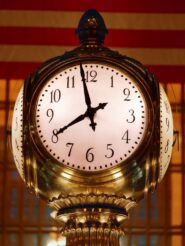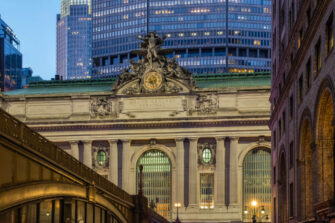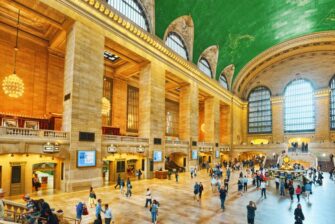Grand Central Terminal Personal Injury Attorney

Grand Central Terminal is a transportation hub — but it’s also a world-famous beaux arts historic landmark in New York City and one of the nation’s great architectural achievements. It’s hailed as a temple to the everyday commuter, a cathedral-like building that honors its visitors, according to the terminal’s website.
The terminal is the home of the MTA Metro-North Railroad and a popular subway station, serving the 4, 5, 6, 7 and S subway lines. It also includes 60 shops, 35 eateries and a calendar of events such as food tastings, art exhibits and a craft market.
It’s best known for its unique architectural features, including the Main Concourse ceiling with 12 constellations painted in gold leaf plus 2,500 stars, with 59 stars illuminated by LEDs.
Key Features of the Landmark
Table of Contents
Below the concourse ceiling is an information booth with an analog clock mounted on top, an inner landmark for meeting up with friends for decades.
Chandeliers weighing 2,500 pounds and glowing with 132 bulbs each decorate Vanderbilt Hall inside the terminal.
The terminal’s oldest restaurant, the Grand Central Oyster Bar & Restaurant, offers 25 types of fish, up to 30 varieties of oysters, and an award-winning wine list. The low ceramic arches outside the Oyster Bar create a “whispering gallery,” an acoustic phenomenon where you can lean into one corner, have a friend stand in an opposite one, and talk to each other.
No mention of Grand Central would be complete without the Tiffany clock above the main entrance and overlooking the Pershing Square Viaduct. This 48-foot-high clock is 14 feet in diameter and features statues of the Roman gods Mercury (speed), Hercules (strength) and Minerva (intellect). Together, the three represent the virtues of the railroad.
History of Grand Central Terminal
 1869: Shipping magnate Cornelius Vanderbilt, who had acquired the Hudson River Railroad and added the New York Central Railroad to his holdings, purchases property between East 42nd and 48th streets and from Lexington to Madison avenues to construct a new rail yard and train depot.
1869: Shipping magnate Cornelius Vanderbilt, who had acquired the Hudson River Railroad and added the New York Central Railroad to his holdings, purchases property between East 42nd and 48th streets and from Lexington to Madison avenues to construct a new rail yard and train depot.
1871 to 1900: The Grand Central Depot serves three distinct rail lines, each with separate ticketing operations, waiting rooms and baggage facilities.
1902: The New York Central and Hudson River Railroad announce plans to demolish the existing station and create a new double-level terminal for electric trains.
1903: New York architects Warren and Wetmore along with Reed and Stem unveil the design for the new terminal.
1913: Grand Central Terminal officially opens to the public, although train service during its construction was never disrupted.
1967: New York City’s Landmarks Preservation Commission designates the terminal as a landmark, subject to protection under the law.
1968: Developer UGP Properties proposes building a 55-story tower above the terminal, which would have demolished the main waiting room and part of the main concourse. The city blocks the project, leading to a protracted legal battle.
1976: Former First Lady Jacqueline Kennedy Onassis joins other city leaders to rally for the terminal. The National Register of Historic Places designates Grand Central Terminal as a national historic landmark.
1990: A $425 million master plan adopted by the Metropolitan Transit Authority, along with an investment of $160 million, revitalizes the terminal, including upgrading utilities and making structural repairs.
1998: The renovation and construction begins with the cleaning of the Main Concourse’s sky ceiling, returning the terminal to its original splendor.
Location & Tourism
Grand Central Terminal is located at 89 E. 42nd St. in Manhattan. Although the businesses within keep their own hours, the terminal itself is open around the clock because of the train and subway traffic.
Interesting Facts About Grand Central Terminal
- Calling the place “Grand Central Station” is a misnomer. That actually refers to the U.S. Post Office or the subway station below the terminal. (The proper name is Grand Central Terminal, “Grand Central,” “the Terminal” or “GCT.”)
- Grand Central Terminal has housed an art school, an art gallery, a rail history museum, a newsreel movie theater, and CBS Television studios at various times. It also has hosted art installations, a high-wire walk, break dancing, boxing and Double Dutch tournaments. Its recently refurbished tennis club first opened in 1965.
- All the clocks in Grand Central are set by the atomic clock in the Naval Observatory in Bethesda, Maryland.
- Befitting a train terminal, Grand Central’s self-guided audio tour includes “local” and “express” options allowing viewers to choose how much information they’d like.
- The Main Concourse ceiling retains one small, dark patch of brick next to the constellation of Cancer, the crab, to reveal what the ceiling looked like before its restoration. Tests showed it became discolored from mostly nicotine and cigarette tar.
Directions to Belluck & Fox from Grand Central Terminal
Belluck & Fox’s NYC office is located at 546 Fifth Ave., 5th Floor, New York NY 10036. From the front of the terminal, head west on East 42nd Street and turn right to go north on Madison Avenue. Turn left onto East 47th Street, then left onto Fifth Avenue. In good weather, our Midtown law office is within about five minutes’ walking distance. Simply walk west on East 42nd Street for two blocks and turn right onto Fifth Avenue.
CONTACT OUR NEW YORK INJURY LAW FIRM TODAY
At Belluck & Fox, LLP, our New York City mesothelioma lawyers have been strongly fighting for the rights of individuals and families throughout Manhattan and other nearby places for more than two decades. Contact us today to know more information. Call (212) 681-1575 or fill out our online contact form to get started with a free consultation.